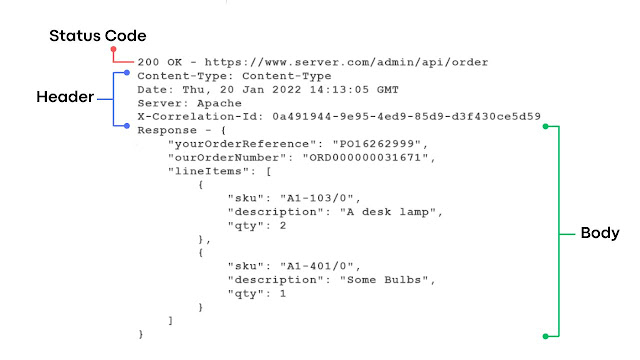What is HTTP Response?
An HTTP response is a message sent by a server to a client as a result of an HTTP request. It contains information about the status of the request and may also include data requested by the client. The response typically includes a status code, a header providing additional information, and in some cases, a body containing the requested content. The status code indicates whether the request was successful, encountered an error, or requires further action.
HTTP responses are a fundamental part of web communication, allowing servers to provide clients with the necessary information to display web pages, images, or other resources.
Components of HTTP Response.
There are several components present in different types of HTTP responses but the three most important components are Status Code, Header, and Body. Let's discuss each of them in detail.
1. Status Line.
The status line is the opening act of an HTTP response, conveying critical information about the success or failure of the request. It comprises the HTTP version, a three-digit status code, and a human-readable status message.
Status Code and Description:
| Status Code | Meaning |
|---|---|
| Informational (1xx) | Informational status codes signify that the server received the request and is continuing to process it. These responses set the stage for the upcoming actions. |
| Success (2xx) | Success codes indicate that the client's request was successfully received, understood, and accepted. These responses bring a sense of accomplishment to the interaction. |
| Redirection (3xx) | Redirection codes inform the client that additional action is needed to fulfill the request. They guide clients to a new location or resource. |
| Client Error (4xx) | Client error codes point to issues on the client side, indicating that the request cannot be fulfilled. These responses offer insights into corrective actions. |
| Server Error (5xx) | Server error codes highlight issues on the server side, suggesting that the server failed to fulfill a valid request. These responses prompt investigation and resolution. |
Example:
HTTP/1.1 200 OK
2. Response Headers.
Headers in an HTTP response carry additional information about the server's response, ranging from content type and length to server information and caching directives. Understanding these headers is essential for efficient communication.
Example:
Content-Type: text/html Content-Length: 1024 Server: Apache/2.4.29 (Ubuntu)
- Content-Type: The Content-Type header informs the client about the type of data being returned. It can specify whether the content is HTML, JSON, XML, or another format, guiding the client in proper interpretation.
- Content-Length: The Content-Length header indicates the size of the response body in bytes. This crucial information aids clients in efficiently handling and parsing the received content.
3. Response Body.
The HTTP response body is a crucial component of an HTTP response sent by a server to a client after receiving a request. It contains the actual data or content requested by the client. The structure and content of the body depend on the nature of the request and the resource being accessed. This could be HTML content, JSON data, or binary files, depending on the nature of the request.
Example (JSON):
{
"status": "success",
"data": {
"user": "John Doe",
"role": "Admin"
}
}
These are the three important components of HTTP response and apart from this we also have other components like Cookies and Rediction.
4. Cookies.
Cookies are small pieces of data sent from the server and stored on the client's side. They play a crucial role in maintaining stateful sessions and user authentication. The "Set-Cookie" header in an HTTP response instructs the client to store a particular cookie, while the "Cookie" header in subsequent requests sends the stored cookies back to the server.
5. Redirection.
HTTP responses often include redirection codes (3xx series) to instruct the client to navigate to a different location. This is commonly used for URL changes or when a resource has been moved permanently or temporarily.
Best Practices and Considerations.
- Content Negotiation: Implementing content negotiation allows clients and servers to agree on the most suitable representation of a resource. This enhances flexibility and improves user experiences.
- Compression: Utilizing compression mechanisms, such as gzip, reduces response size, leading to faster transmission and improved overall performance.
- Cache-Control: Properly configuring cache control headers ensures efficient caching of responses, reducing the need for repeated requests and optimizing resource usage.
Conclusion.
Mastering the intricacies of the HTTP response structure empowers developers to create robust and responsive web applications. By understanding the nuances of status codes, headers, and content, developers can navigate the web response landscape with confidence, delivering optimal user experiences.
In summary, the HTTP response structure encapsulates a wealth of information, and a thorough comprehension of its components is fundamental for any developer aiming to build high-performance and user-friendly web applications.











No comments
Post a Comment